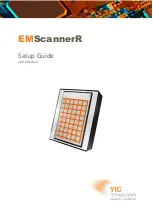
9640A
Instruction Manual
5-44
Note
The above procedure and test points listed in Tables 5-19 and 5-20 verify
the performance of all the level control and attenuation circuits that
determine level accuracy throughout the entire amplitude range, avoiding
the need to make difficult precision level measurements at extremely low
levels below -101 dBm. However, the following optional ultra-low level
measurement procedure is provided for users choosing to verify the lower
level outputs directly.
If required, use the following optional procedure to verify the absolute level accuracy of
the UUT below -101 dBm.
Note
Ultra-Low level measurements are made relative to levels previously
measured with the measuring receiver. Two levels (-91dBm and -101 dBm)
are used as reference points to provide the required UUT hardware
configurations for the subsequent tests. The value of the output level at -91
dBm and -101 dBm measured in steps 30 through 37 above will be used as
references in the following procedure, identified as P
-91
and P
-101
respectively for each test frequency. It is important that the correct
sequence is followed as described.
Making these precision ultra-low level measurements requires appropriate
choice of measuring receiver settings to provide adequate linearity, noise
floor, and reading repeatability throughout the amplitude range required.
For any given frequency the measuring receiver the settings must be
maintained for all amplitudes at that frequency after establishing the
reference point. In particular, receiver attenuator, reference level, and
resolution bandwidth settings must not change.
28.
On the UUT enable the REF FREQUENCY OUTPUT at 10 MHz and set the UUT as
follows:
Frequency 10
MHz
Level -91
dBm
Output
OPER
29.
Allow the measuring receiver to tune the input signal, and then set the controls to
measure RF level, relative (dB) to the current input level.
30.
Without changing any measuring receiver settings, set the UUT to the next amplitude
listed in Table 5-21 for this frequency. Allow the measuring receiver reading to
stabilize and record the reading as
P
rel
. (Note that
P
rel
will be a negative number in
dB).
31.
Calculate the UUT output
P
out
=
P
-91
+
P
rel
. Check that the value of
P
out
is within
the tolerance shown in part A of Table 5-21.
32.
Repeat steps 30 and 31 for each amplitude listed in part A of Table 5-21 for this
frequency.
33.
Return the UUT output to -91dBm, set the UUT frequency to the next frequency
listed in part A of Table 5-21, and repeat steps 29 through 32.
34.
Set the UUT to 10 MHz at -101dBm. Repeat steps 39 through 43 for the points listed
in part B of Table 5-21 using the calculation
P
out
=
P
-101
+
P
rel
in step 31.
35.
Set the UUT to
STBY
.
Summary of Contents for 9640A Series
Page 8: ......
Page 16: ...9640A Instruction Manual viii...
Page 22: ...9640A Instruction Manual 1 2...
Page 40: ...9640A Instruction Manual 2 2...
Page 108: ...9640A Instruction Manual 4A 2...
Page 138: ...9640A Instruction Manual 4C 2...
Page 164: ...9640A Instruction Manual 4D 2...
Page 168: ...9640A Instruction Manual 4D 6...
Page 170: ...9640A Instruction Manual 4E 2...
Page 174: ...9640A Instruction Manual 4E 6...
Page 176: ...9640A Instruction Manual 4F 2...
Page 184: ...9640A Instruction Manual 4F 10...
Page 186: ...9640A Instruction Manual 4G 2...
Page 190: ...9640A Instruction Manual 4G 6...
Page 192: ...9640A Instruction Manual 5 2...
Page 272: ...9640A Instruction Manual 5 82...
Page 274: ...9640A Instruction Manual 6 2...
Page 284: ...9640A Instruction Manual 7 2...
Page 310: ...9640A Instruction Manual 8 2...
Page 316: ...9640A Instruction Manual 8 8...
Page 320: ...9640A Instruction Manual A 4...
















































